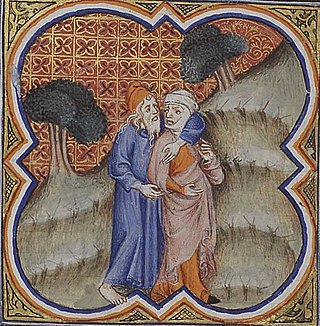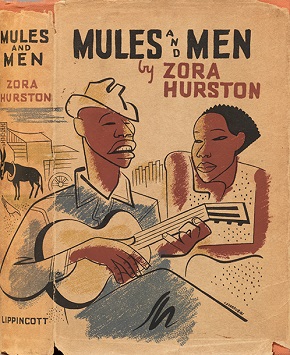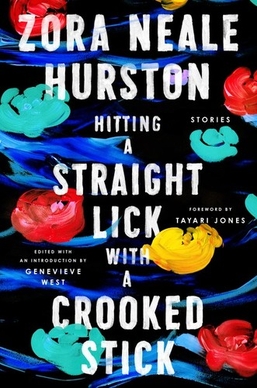Related Research Articles
The Book of Hosea is collected as one of the twelve minor prophets of the Nevi'im ("Prophets") in the Tanakh, and as a book in its own right in the Christian Old Testament. According to the traditional order of most Hebrew Bibles, it is the first of the Twelve.

Zora Neale Hurston was an American author, anthropologist, and filmmaker. She portrayed racial struggles in the early-1900s American South and published research on hoodoo. The most popular of her four novels is Their Eyes Were Watching God, published in 1937. She also wrote over 50 short stories, plays, and essays.
Their Eyes Were Watching God is a 1937 novel by American writer Zora Neale Hurston. It is considered a classic of the Harlem Renaissance, and Hurston's best known work. The novel explores protagonist Janie Crawford's "ripening from a vibrant, but voiceless, teenage girl into a woman with her finger on the trigger of her own destiny".

John the Conqueror, also known as High John de Conqueror, John, Jack, and many other folk variants, is a folk hero from African-American folklore. He is associated with the roots of Ipomoea purga, the John the Conqueror root or John the Conqueroo, to which magical powers are ascribed in African-American folklore, especially among the Hoodoo tradition of folk magic. Muddy Waters mentions him as Johnny Cocheroo in the songs "Mannish Boy" and "I'm Your Hoochie Coochie Man". In "Mannish Boy", the line is "I think I'll go down/To old Kansas too/I'm gonna bring back my second cousin/That little Johnny Conqueroo" and in "I'm Your Hoochie Coochie Man", it is called "John De Conquer Blue".

Their Eyes Were Watching God is a 2005 American television drama film based upon Zora Neale Hurston's 1937 novel of the same name. The film was directed by Darnell Martin, written by Suzan-Lori Parks, Misan Sagay, and Bobby Smith Jr., and produced by Oprah Winfrey's Harpo Productions. It stars Halle Berry, Ruben Santiago-Hudson, and Michael Ealy, and aired on ABC on March 6, 2005.
Ruby McCollum, born Ruby Jackson, was a wealthy married African-American woman in Live Oak, Florida, who is known for being arrested and convicted in 1952 for killing Dr. C. Leroy Adams, a prominent white doctor and state senator–elect. She testified as to their sexual relationship and his paternity of her child. The judge prohibited her from recounting her allegations of abuse by Adams. She was sentenced to death for his murder by an all-white jury. The sensational case was covered widely in the United States press. McCollum was subjected to a gag order. Her case was appealed and overturned by the State Supreme Court.

Cudjoe Kazoola Lewis, born Oluale Kossola, and also known as Cudjo Lewis, was the third to last adult survivor of the Atlantic slave trade between Africa and the United States. Together with 115 other African captives, he was brought to the United States on board the ship Clotilda in 1860. The captives were landed in backwaters of the Mobile River near Mobile, Alabama, and hidden from authorities. The ship was scuttled to evade discovery, and remained undiscovered until May 2019.

Africatown, also known as AfricaTown USA and Plateau, is a historic community located three miles (5 km) north of downtown Mobile, Alabama. It was formed by a group of 32 West Africans, who in 1860 were bought and transported against their will in the last known illegal shipment of slaves to the United States. The Atlantic slave trade had been banned since 1808, but 110 slaves held by the Kingdom of Dahomey were smuggled into Mobile on the Clotilda, which was burned and scuttled to try to conceal its illicit cargo. More than 30 of these people, believed to be ethnic Yoruba, Ewe, and Fon, founded and created their own community in what became Africatown. They retained their West African customs and language into the 1950s, while their children and some elders also learned English. Cudjo Kazoola Lewis, a founder of Africatown, lived until 1935 and was long thought to be the last survivor of the slaves from the Clotilda living in Africatown.

Mule Bone: A Comedy of Negro Life is a 1930 play by American authors Langston Hughes and Zora Neale Hurston. The process of writing the play led Hughes and Hurston, who had been close friends, to sever their relationship. Mule Bone was not staged until 1991, when it was produced in New York City by the Lincoln Center Theater.
Charlotte Osgood Mason, born Charlotte Louise Van der Veer Quick, was an American socialite and philanthropist. She contributed more than $100,000 to a number of African-American artists and writers of the Harlem Renaissance, equal to more than $1 million in 2003. This was especially critical during the Great Depression, when foundation support declined. She helped young artists become established.

Gomer was the wife of the prophet Hosea, mentioned in the Hebrew Bible's Book of Hosea (1:3). English translations of Hosea 1:2 refer to her alternatively as a "promiscuous woman" (NIV), a "harlot" (NASB), and a "whore" (KJV) but Hosea is told to marry her according to Divine appointment. She is also described as the daughter of Diblaim.

"Sweat" is a short story by the American writer Zora Neale Hurston, first published in 1926, in the first and only issue of the African-American literary magazine Fire!!. The story revolves around a washerwoman and her unemployed husband.

Mules and Men is a 1935 autoethnographical collection of African-American folklore collected and written by anthropologist Zora Neale Hurston. The book explores stories she collected in two trips: one in Eatonville and Polk County, Florida, and one in New Orleans. Hurston's decision to focus her research on Florida came from a desire to record the cross-section of black traditions in the state. In her introduction to Mules and Men, she wrote, "Florida is a place that draws people—white people from all over the world, and Negroes from every Southern state surely and some from the North and West". Hurston documented 70 folktales during the Florida trip, while the New Orleans trip yielded a number of stories about Marie Laveau, voodoo and Hoodoo traditions. Many of the folktales are told in vernacular; recording the dialect and diction of the Black communities Hurston studied.
Jonah's Gourd Vine is Zora Neale Hurston's 1934 debut novel. The novel is a semi-autobiographical novel following John Buddy Pearson and his wife, Lucy. The characters share the same first names as Hurston's parents and make a similar migration from Notasulga, Alabama to Hurston's childhood home, Eatonville, Florida.
Moses, Man of the Mountain is a 1939 novel by African-American novelist and anthropologist Zora Neale Hurston. The novel rewrites the story of the Book of Exodus of Moses and the Israelites from an Afro-American perspective. The novel applies a number of different motifs and themes commonly addressed in African-American culture, subverting the Moses story.

Seraph on the Suwanee is a 1948 novel by African-American novelist Zora Neale Hurston. It follows the life of a White woman and the fraught relationship she has with her husband and family.
"How It Feels To Be Colored Me" (1928) is an essay by Zora Neale Hurston published in World Tomorrow as a "white journal sympathetic to Harlem Renaissance writers", illustrating her circumstance as an African-American woman in the early 20th century in America. Most of Hurston's work involved her "Negro" characterization that were so true to reality, that she was known as an excellent anthropologist.

Barracoon: The Story of the Last "Black Cargo" is a non-fiction work by Zora Neale Hurston. It is based on her interviews in 1927 with Oluale Kossola who was presumed to be the last survivor of the Middle Passage. Two female survivors were subsequently recognized but Cudjoe continued to be identified as the last living person with clear memories of life in Africa before passage and enslavement.
Emma Langdon Roche was an American writer and artist, best known for her work Historic Sketches of The South (1914).

Hitting a Straight Lick with a Crooked Stick is a compilation of recovered short stories written by Zora Neale Hurston. It was published in 2020 by Amistad: An Imprint of HarperCollins publishers. ISBN 978-0-06-291579-5
References
- ↑ Hurston, Zora Neale (1986). The Gilded Six-Bits. Minneapolis, Minn: Redpath Press. p. 36. ISBN 978-1-55628-006-1.
- 1 2 German, Norman. "Counterfeiting and a Two-Bit Error in Zora Neale Hurston's 'The Gilded Six-Bits'" (PDF). Retrieved 15 November 2011.
- ↑ Mark, Dr. (September 2011). "Zora Neale Hurston-The Gilded Six-Bits" . Retrieved 15 November 2011.
- ↑ Uppling, Jill (July 1996). "American Literature Research and Analysis Website" . Retrieved 17 November 2011.